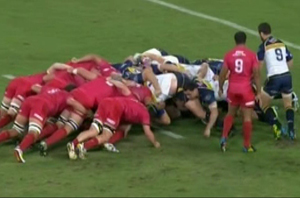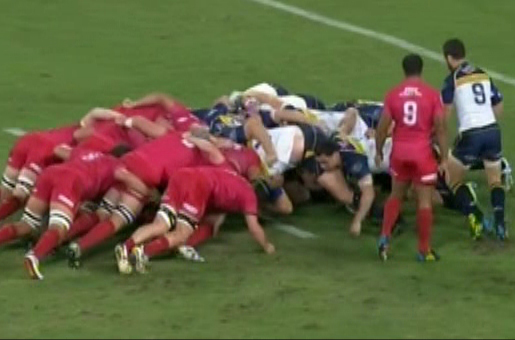 We’ve all been lauding the powerful Brumbies scrum in 2013 and there have been plenty of suggestions that the Wallabies should just pick the Brumbies front row to start the first test against the Lions. There’s also been a lot of comment about the weakness of the Reds scrum.
We’ve all been lauding the powerful Brumbies scrum in 2013 and there have been plenty of suggestions that the Wallabies should just pick the Brumbies front row to start the first test against the Lions. There’s also been a lot of comment about the weakness of the Reds scrum.
Dan Palmer told us recently on the Podslam that the Brumbies are trying to use their scrum as a weapon to attack the opposition and coming into last weekend’s match between the two teams I commented that the Reds scrum would really have to step up to combat the power of the Brumbies.
How did the two teams perform in this crucial area? There were twelve scrums in the match – seven fed by the Brumbies and five fed by the Reds. The Reds won all of their scrums (100%). The Brumbies won five of their seven (71%) with Ben Alexander conceding two penalties, one for going to ground under pressure and the other for having his hand on the ground.
So, a pretty clear victory for the Reds – they not only thwarted the Brumbies much vaunted scrum but they dominated, or so the stats say!
Let’s take a closer look at the scrums to see whether there is any difference between the stats and which scrum was dominant.
Firstly, let’s look at which scrum went forward – that’s always a pretty good sign of which scrum was dominant. Even if the opposition feed the ball and win it, if your scrum is moving forward that signals you’ve got the opposition under pressure and there’s a good chance that dominance will lead to some return later in the match if you can keep that pressure up.
In the video accompanying this article I’ve included a graphic for each scrum indicating which scrum was going forward and importantly, which side of the scrum was going forward. This analysis helps us to work out which props for each team were most effective, which would also indicate they got good support from the lock and flanker in their pod.
Of the twelve scrums in the match, I marked five neutral where neither team really went forward. In three scrums the Brumbies went forward on both sides of the scrum. In one scrum the Reds went forward with both sides and in the remaining three the Reds went forward on their loosehead side. Overall that’s four scrums where the Reds went forward and three where the Brumbies went forward so the result was a lot closer under that measure than the percentage won.
The other thing to watch out for when trying to work out which scrum is dominant is which team is folding in or going to ground under pressure. This is where the analysis gets really interesting and opens up the opportunity for a debate! If a prop folds in or goes to ground, was it a result of something illegal the other pack did or does it indicate which scrum is weaker? Here’s my view on each scrum:
- Alexander missed his bind but didn’t go to ground and then drove through James Slipper. Slipper wasn’t helped by Ed Quirk behind him who added no weight to counter the push. Once the Reds were going backward, Palmer got his side moving forward as well. The Brumbies were completely dominant in this scrum and the Reds were correctly penalised;
- Neither side managed to go forward but Greg Holmes was penalised for driving on the angle. When you watch the video you’ll see that it was actually Palmer that was at fault in this scrum – he didn’t engage straight, didn’t bind and folded in which caused Holmes to follow him in and down. The referee got this penalty wrong;
- Both Slipper and Alexander started square and flat but then you’ll see in the video Alexander’s elbow is pointing to the ground just before he hinges under pressure. He then went to ground and was correctly penalised;
- A relatively neutral scrum. The Brumbies did go to ground but by then the ball was at the back so no need for it to be pulled up;
- On the near side of this scrum Slipper gets very low and this causes Alexander to hinge but he maintained his bind and got back up and drove forward. On the far side the referee penalised Holmes for going to ground but there’s no footage to comment on. The Brumbies were the dominant scrum going forward so it’s likely Holmes did go down;
- Palmer drove on the angle in this scrum and when he folded in, Holmes followed him. This meant the Reds loosehead side went forward but Holmes went to ground as he had nothing to push on. It should have been a penalty against Palmer but the ball came out so the referee allowed play to go on, which allowed the game to continue on;
- Holmes dominated Alexander in this scrum with the Reds loosehead side going forward;
- A neutral scrum with the ball in and out very quickly;
- The Reds dominated this scrum with both sides moving forward;
- A neutral scrum – the far side went down but there’s no footage to comment on;
- The Brumbies dominated this scrum even with Pat McCabe packing at flanker but Alexander was penalised for dropping his hand on to the ground;
- Holmes dominated Palmer in this scrum – when you watch the video look at how Palmer folded in under pressure and his angle compared to the rest of the scrum. The Brumbies were one man short for this scrum but they went to ground before the Reds could take advantage of that advantage.
On that analysis the Reds were dominant in five scrums and the Brumbies three, with four neutral.
Analysing the scrums in three different ways – percentage won, moving forward and under pressure – the result is the same. The Reds were the dominant scrum in this match.
Holmes was the dominant prop on his side of the scrum in this match but has been a penalty magnet this year for the Reds earning 15 penalties against him and Alexander’s not been much better for the Brumbies, conceding 13. Alexander, Palmer and Slipper must all be in contention for the Wallabies starting pack but in my opinion, Alexander’s scrummaging doesn’t warrant his inclusion as anything more than a bench option.
I believe Benn Robinson should start at loosehead for the Wallabies with Palmer and Slipper the options to start at tighthead. Palmer has been scrummaging really well this year and his general play has also improved. However, Slipper showed in Saturday night’s match that his scrummaging is close to par with Palmer and his general play is much better.
Slipper played the full match on Saturday whilst Palmer only played 60 minutes. Palmer made nine tackles, missed one and only ran the ball once – he was also first into just one breakdown. Slipper made ten tackles, missed one and ran the ball eight times – he was also first into eight breakdowns. If he continues to scrummage well, the difference in general play numbers in Slipper’s favour is too big too ignore.
Surprisingly after that performance, Palmer made the Green & Gold Rugby team of the week ahead of Slipper! Regardless of which of them starts at tighthead for the Wallabies, I expect the other will be on the bench together with Alexander.


